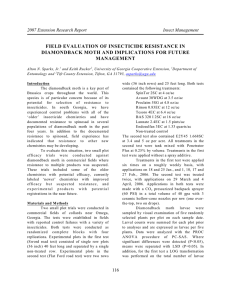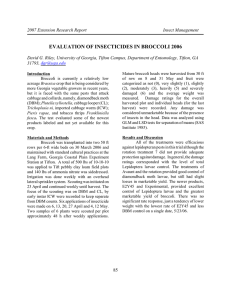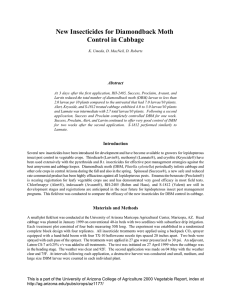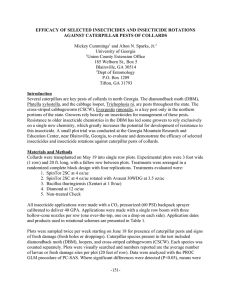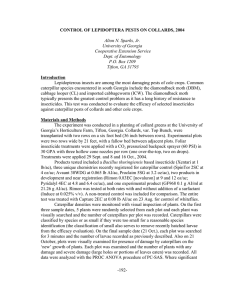Alton N. Sparks, Jr. and Keith Rucker Dept of Entomology University of Georgia
advertisement
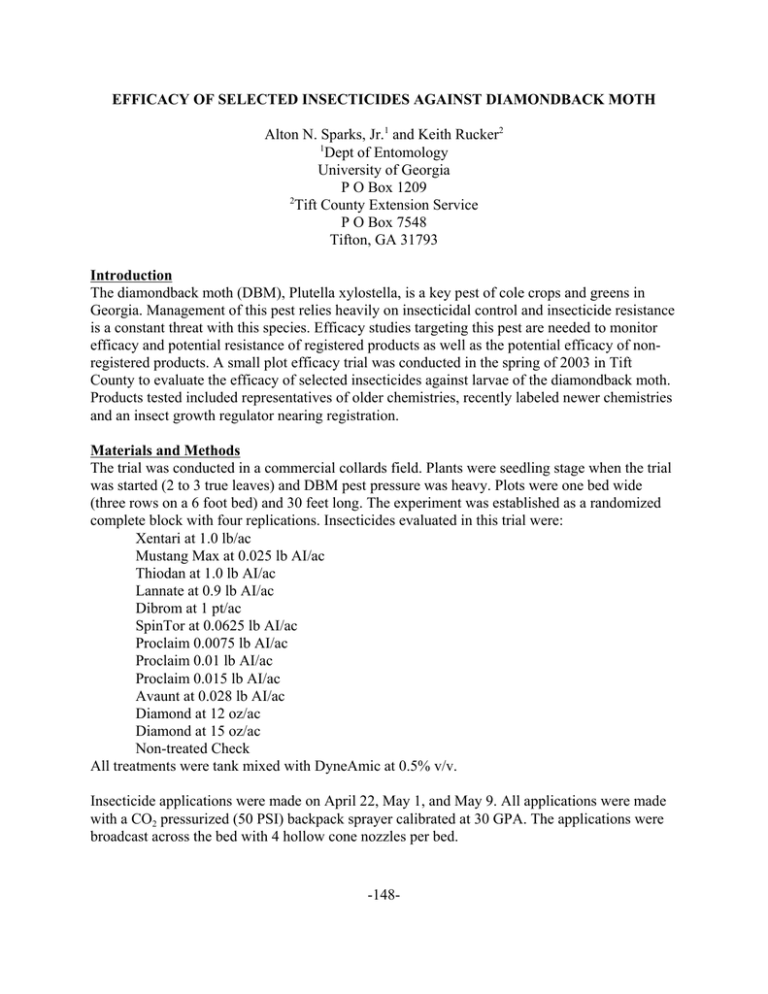
EFFICACY OF SELECTED INSECTICIDES AGAINST DIAMONDBACK MOTH Alton N. Sparks, Jr.1 and Keith Rucker2 1 Dept of Entomology University of Georgia P O Box 1209 2 Tift County Extension Service P O Box 7548 Tifton, GA 31793 Introduction The diamondback moth (DBM), Plutella xylostella, is a key pest of cole crops and greens in Georgia. Management of this pest relies heavily on insecticidal control and insecticide resistance is a constant threat with this species. Efficacy studies targeting this pest are needed to monitor efficacy and potential resistance of registered products as well as the potential efficacy of nonregistered products. A small plot efficacy trial was conducted in the spring of 2003 in Tift County to evaluate the efficacy of selected insecticides against larvae of the diamondback moth. Products tested included representatives of older chemistries, recently labeled newer chemistries and an insect growth regulator nearing registration. Materials and Methods The trial was conducted in a commercial collards field. Plants were seedling stage when the trial was started (2 to 3 true leaves) and DBM pest pressure was heavy. Plots were one bed wide (three rows on a 6 foot bed) and 30 feet long. The experiment was established as a randomized complete block with four replications. Insecticides evaluated in this trial were: Xentari at 1.0 lb/ac Mustang Max at 0.025 lb AI/ac Thiodan at 1.0 lb AI/ac Lannate at 0.9 lb AI/ac Dibrom at 1 pt/ac SpinTor at 0.0625 lb AI/ac Proclaim 0.0075 lb AI/ac Proclaim 0.01 lb AI/ac Proclaim 0.015 lb AI/ac Avaunt at 0.028 lb AI/ac Diamond at 12 oz/ac Diamond at 15 oz/ac Non-treated Check All treatments were tank mixed with DyneAmic at 0.5% v/v. Insecticide applications were made on April 22, May 1, and May 9. All applications were made with a CO2 pressurized (50 PSI) backpack sprayer calibrated at 30 GPA. The applications were broadcast across the bed with 4 hollow cone nozzles per bed. -148- DBM larvae were counted on 10 randomly selected plants per plot on each sample date. Each plant was visually examined and the total number of larvae per 10 plants was recorded. Larval counts were analyzed with the PROC ANOVA procedure of PC-SAS. Where significant differences were detected (P<0.05), means were separated with LSD (P=0.05). Results and Discussion All treatments provided control of DBM by 6 days after the first treatment (4/28) (Table 1). Xentari and Diamond provided slower activity than the other products and were not significantly different from the check at 2 days after the first treatment (4/24). From May 1st on, variation in the data resulted in poor separation of treatments; however, only SpinTor, Proclaim, and Diamond treatments maintained populations below 5 larvae per 10 plants (one commonly published threshold is 3 larvae per 10 plants). Avaunt did not perform as well as expected, but this insecticide was inadvertently applied at less than half of the registered rate. Although visual ratings were not recorded, plots treated with Diamond were easily detected by lack of damage on newer growth, followed closely by plots treated with Proclaim. -149- Table 1. Average number of diamondback moth larvae per 10 plants, Tift County, 2003. Mean number of DBM larvae per 10 plants Treatment 4/23* 4/24 4/28 5/1 12.25 ab 5/5 5/8 5/12 16.00 a 26.00 a 20.50 a 3.75 c 11.25 bc 14.50 abc 7.50 b 23.00 ab 21.50 a Check 7.00 a 7.75 a 7.25 a Xentari 6.25 a 5.25 ab 0.75 b Dibrom 1.50 a 0.25 d 0.50 b Mustang Max 3.00 a 0.75 cd 0.75 b 3.75 cde 8.25 b 12.50 bc Thiodan 1.50 a 3.00 bcd 1.75 b 7.00 bcd 2.00 cd 9.75 bc Lannate 2.25 a 1.00 cd 0.50 b 4.00 cde 1.50 cd 7.25 c Avaunt 2.00 a 0.25 d 1.75 b 8.25 abc 1.00 cd 7.50 c SpinTor 0.50 a 0.50 d 0.25 b 2.25 de 2.50 cd 2.75 c 4.75 def Proclaim.0075 2.25 a 0.25 d 0.00 b 3.25 cde 0.25 d 1.25 c 4.00 def Proclaim.01 3.50 a 0.00 d 0.00 b 4.25 cde 0.00 d 1.50 c 2.50 ef Proclaim.015 1.00 a 0.50 d 0.00 b 2.00 de 0.00 d 0.25 c 7.75 cdef Diamond 12 4.00 a 4.75 abc 0.00 b 0.00 e 0.25 d 0.00 c 1.00 f Diamond 15 3.75 a 5.75 ab 0.50 b 0.25 e 0.00 d Means within columns followed by the same letter are not significantly different (LSD; P=0.05). * Differences were significant at P = 0.086. 0.25 c 1.25 f 7.50 bcd 13.25 a -150- 9.25 bcde 10.50 bcd 7.50 cdef 16.50 ab
